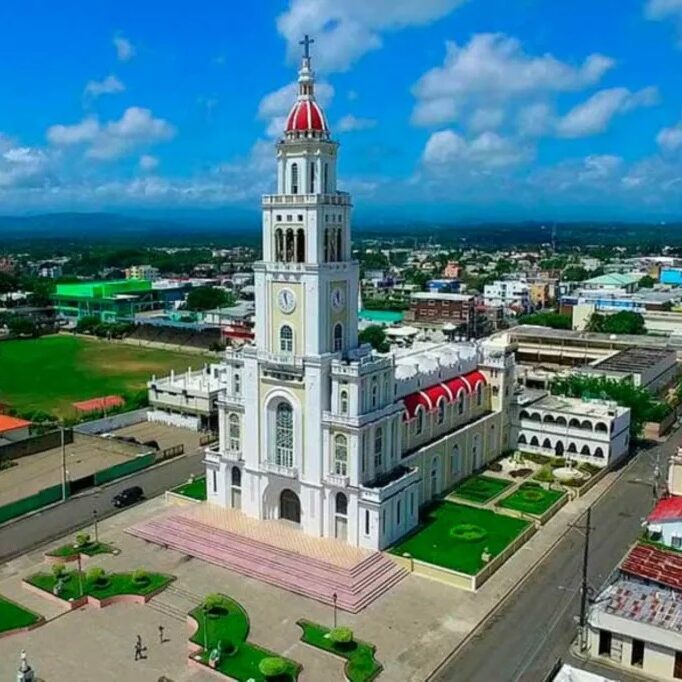


Moca: historical, cultural and gastronomic route In the Dominican Republic there are destinations that are recognized more than others. Perhaps because of its cultural, historical, artistic or gastronomic relevance. One of these is Moca, the head municipality of the Espaillat province. Moca, throughout time, has been the protagonist of several historical events that have made it known as the cradle of great heroes; Important events have been established here such as the “Gesta del 2 de Mayo” in 1861 against the Annexation to Spain, the execution of Ulises Heureaux on July 26, 1899 and the execution of Lilís, to mention some of the most important events. . On this occasion, thanks to a tour that we took with Grupo Sarma and the Ecotourism Cluster of the Espaillat province, we are going to share seven mandatory stops that make up the historical, cultural and gastronomic route of the city considered “capital of mofongo” in the Dominican Republic. Church of the Sacred Heart of Jesus Moca is a town that strongly believes in God and has one of the most beautiful temples in the entire Dominican Republic. This parish was declared a World Heritage Site by UNESCO in 1990 and then Monumental Heritage of the Dominican Republic by the Executive Branch in 2006. Designed by architect Humberto Ruiz Castillo, this temple has a height of 110 meters from the base to the cross that crowns its tower. Its structure is made up of a central nave and 2 lateral ones. Its bell tower is 60 meters high and the clock and its red dome can be seen from every corner of the city of Moca. The interior of the church is magical. There you can see a series of beautiful polychrome stained glass windows with biblical and Salesian representations, an organ with 4000 pipes, 2 keyboards and about 16 Murano glass lamps that illuminate the entire area, as described by Dominicana Life Style. Among its images is: the Heart of Jesus, recreated in white marble; Our Lady of Guadalupe; Christ the Redeemer also has an altar dedicated to Mary Help of Christians and another altar to Saint John Bosco. The Virgin of Altagracia and San José custodian of the sides of the temple. Without a doubt, a temple that you should visit.
This historic space is located in the Estancia Nueva district, where the widow of President Ramón Cáceres settled. If you are interested in knowing a little about the history of the Dominican Republic and the way and lifestyle of this former president, a native of La Estancia, Moca, noted for his opposition to the mandate of the dictator Ulises Heureaux, visiting the museum is an excellent way to connect with your work. This cultural space (@museoramoncaceres), built at the initiative and will of the family, collects the episodes of life and exercise of power of the former president number 39 of the Dominican Republic. With a tour that lasts approximately 15 minutes, new generations can learn about their works and achievements in the economic, political and development areas in favor of the country.
On our tour we made a stop at @las4fmoca, located on the Coronel Lora Fernández highway, in Moca. This break is one of the most important activities when visiting Moca, because there is no tour of this municipality that does not include enjoying a good mofongo. The Las 4F restaurant has more than 10 variations of mofongo on its menu, including some made with cassava – rare but tasty – and all of them can be accompanied with chicharrón, sausage, cheese, carnita, seafood or crab dough. Other dishes that can be enjoyed at Moca are sancocho with various meats, typical sweets, white cheese, and Rodaos.
One of the most recent attractions that the municipality has is 26 de Julio Street, which was painted in three-dimensional form, becoming the first of its kind in the Dominican Republic. This space, which begins right in front of the Plaza 26 de Julio and Museo 26 de Julio, has several illustrated landscapes in 3D format where tourists and locals can take fun photographs. “The 3D street is part of a complete project that seeks to convert that complete road with sections that highlight art, education, technology, communications, fine arts and the history of the province,” said Juan Santiago Cabrera at the time. of the inauguration. This work in the dream occupies about 60 meters and was made by the professor and brush artist Julio Tejada, who captured images that refer to the geographical demarcation of the city.
Another experience that you must live on the historical tour of the city of Moca is the visit to the 16 de Julio Museum (@museo26dejuliard), where young students with enthusiasm and drama will give you a tour of relevant events about Ulises Heureaux, who was murdered on July 26, 1899. This historic space was inaugurated on July 26, 2015, within the framework of the commemoration of the 116th anniversary. It is located in the small square that pays tribute to Ramón Cáceres, Horacio Vásquez, Manuel Cáceres, Jacobo de Lara, Pablo Arnaud and many others like Eduardo Contín, heroes of the tyrant’s execution. The house where the museum is located was donated by the De Lara family, from where Jacobito De Lara fired the first shot against Lilís. Here there are several paintings that depict what happened in the assassination of President Ulises Heureaux by several young Mocanos. The museum, located on Colon Street, in front of 26 de Julio Street, is a replica of the original building, using skylights that were found in the exterior and interior doors of the old house, as part of the museography and exhibition with portraits, paintings and objects of the time.